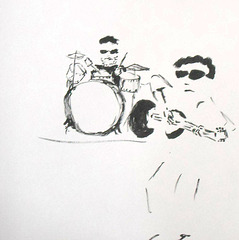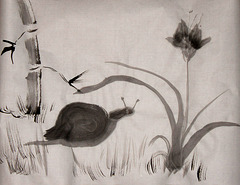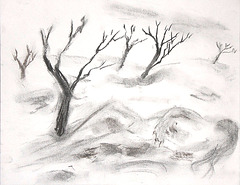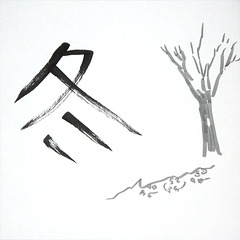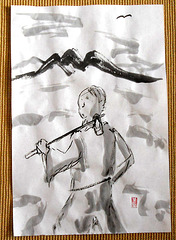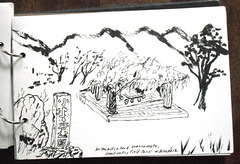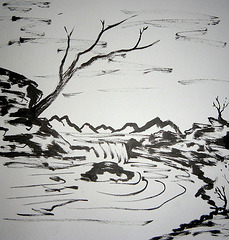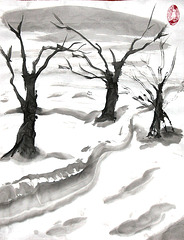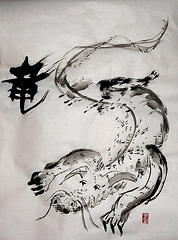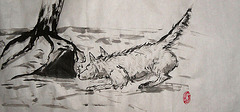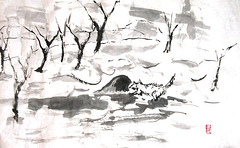
sumi-e
Japanese ink painting
You go Joe B
| |
|
Listening to some great music the other night and...
Brushed ink on 12 by 12 inch card stock.
障子に映る影
| |
|
障子に映る影 (Shoji ni utsuru kage), shadow's on the shoji.
Shoji being the wood framed paper screens often used as windows/doors/walls in Japan.
OK, back in the day, back in the later 1890's, there was this guy in Japan named Lafcadio Hearn, born in Greece, raised in Ireland, worked as a journalist in America. went to Japan, wrote, married, and lived a relatively short but happy life.
While reading his book, "Kokoro, Japanese Inner Life Hints", I came across this little conceit: "…the morning sun paints upon my shoji, across squares of gold light, the perfect sharp shadow of a little peach tree. ... Limned in dark blue against the yellow glow, the marvelous image shows stronger or fainter tones according to the varying distance of the unseen branches outside."
Having been startled and amused by more than a few shadows on shoji myself, I felt strongly moved to do this sumi-e.
I had my Japanese best friend check my 'spelling' of 障子に映る影(Shoji ni utsuru kage) on the right and… since I wrote vertically I should have put the 子 (ji) below the 障(sho), instead of beside it. Oh well… give me 74 more years to study and practice and I may get it right. :-)
Sumi-e, brushed ink on 'rice' paper, 14 by 21 inches. Unmounted.
Time enough
After Hakuin Ekaku
| |
|
A blind man, an ant and a serpent crossing a chasm on a log.
Slightly after Hakuin Ekaku,(白隠 慧鶴), 1686 - 1768, Zen Buddhist monk/artist. (He painted Two Blind Men Crossing a Log Bridge)
Hum. The snake will make it across OK, as will the ant -but the blind man?
Perhaps it as Goso said, “To give an example, it is like a buffalo passing through a window. Its head, horns and four legs have all passed through. Why is it that its tail cannot?” (By the way: Hakuin Ekaku felt this one one of the eight brain frying koans {Hachi Nanto} necessary to understand if one wants to get their journeyman union card as an enlightened Buddhist.)
Brushed ink (sumi-e) on "rice" paper, 13 1/2 by 24 inches. Unmounted.
The model as part of a snowscape
| |
|
|
I've been playing with this idea for a while, the model as a landscape, etc. Most of these are in my 'Model as a 'scape' set.
Alaskan williow charcoal (that I made) on 11 by 14 inch sketch paper.
and then there's the watcher
冬 fuyu
| |
|
冬, fuyu, -or winter.
Faber Castell's Pitt artist pen and brushed ink on 12 by 12 inch card stock.
Bodhidharma heading home
Up in the valley
| |
|
A few days before coming back here to Alaska from Shikoku Island, Japan, we walked waaaaay up in to the hills and found this little park. The name of the park, written on the post to the left, reads Small Vally Field Park.
Brushed ink on sketch paper.
Dreamtime
Outflow
Bamboo
| |
|
I've said before that Sumi-e, Japanese ink painting, is something that I enjoy doing but thatI never expect to master.
It's said by many sumi-e artists that if one can paint correctly 'the four gentlemen' (wild orchid, plumb, bamboo and chrysanthemum), one has mastered sumi-e in so far as the using the strokes, tonal values, etc., necessary to paint those correctly, one can paint any subject.
However…
One American that studied sumi-e extensively notes -just concerning the bamboo:
"…Nothing is more difficult to paint correctly than this plant. Plate LIII shows the bamboo with its essentially
component parts and forms indicated as follows: The upright stalk is in five subdivisions (1 to 5), each
differing in length but all suggesting the Chinese character for one (ICHI) painted upright. These are separated
from each other by strokes reproducing the Chinese characters for positively (22), for heart (23), for second
(24), for one (25), and for eight (26). The stem (6 to 10) is composed of rats' tails. The manner of painting and
combining the leaves of the bamboo is called take no ha no kumitata and is minutely described and illustrated
in Ransai's great work, Gwa Fu. The essentials are: The five-leaf arrangement (GO YO) (11 to 15) with the
ornament (16), called kazari. The three-leaf arrangement (17 to 19) called KO JI, from its resemblance to the
Chinese character KO (32). The two-leaf arrangement (20 and 21) called JIN JI, from its resemblance to the
character JIN (33), a man. In further development of the plant the following imitative arrangements of the leaves
are used: The fish tail (GYO BI) (27), the goldfish triple tail (KINGYO BI) (28), the swallow tail (EN BI) (29), the
Chinese character for bamboo (CHIKU JI) (30), and the seven-leaf arrangement (SHICHI YO) (31). It will be
observed how the odd or positive numbers (YO) are favored. The foregoing method is used by the Okyo
painters.
The Kano artists have another system for combining and elaborating the leaf growth, but it does not differ
radically from that here given. The leaf of the bamboo reproduces the shape of a carp's body (34). It also
resembles the tail feathers of the phoenix. …"
From: "On the Laws of Japanese Painting:
By: Henry P. Bowie
Published 1911 by Paul Elder and Company Publishers
The above painting: Sumi-e on 'rice' paper, unmounted. 8 by 24 inches.
Waiting
竜, たつ, tatsu, dragon
Occidental Daruma
| |
|
The temperature outside today is a balmy -17°F. ( -27° C.). I spent much of yesterday plowing snow. So, today seemed like a good day to put some music on, grind some ink on a suzuri, lay some gasen paper on felt, take fude (brush) in hand and paint some sumi-e.
This 'Occidental Daruma' is one of the sumi-e that I painted today.
The Indian sage, Bodhidharma, known as Daruma in Japan, is considered the father of Zen Buddhism. In many Japanese renderings he appears rather fierce and cranky (Hey if you spent nine years staring at a cave wall, you might end up a tad belligerent too!).
OK I punned a bit with the title, I suspect that Daruma/Bodhidharma, in 5th century India. had no clear intention of founding Zen Buddhism, hence an accidental, not intended result of his actions. None the less a sect in Japan, the Tendai sect, claimed that Daruma traveled from the west (the occident) to Japan meeting with Prince Shoutoku Taishi, an early patron on Buddhism.
Meanwhile; Sumi-e on shuji gami paper, 18 by 18 inches
Curious
| |
|
While I was painting the 'Returning', I wanted to take a closer look at the wolf, hence this sumi-e. This wolf is younger than the one in 'Returning' , the shortness of his body suggests a juvenile, and he is brim full of curiosity!
The hanko, (the red stamp,in the lower right that I used to sign this work) was carved for me by Oka Isso in Japan, at the request of a good friend of mine. The hanko is a styilized version of the kanji, the word , zoku, written in kanji it's 俗, or written in hiragna it's ぞく.
In her stylized version of 俗 (zoku) Okasan sees the first half of the kanji, 人 (pronounced to, thats a long 'o' not a 'yu' sounds, more like toe), which means person, she sees as a bird rising. The second half, 谷 (tani), meaning valley, she represented by the lines below and to the right and left of the bird.
俗 (zoku): Okasan says that it, in English, means local manners or folkways. Personally there is another meaning for the kanji that I like better: It also means just a common man.
Since the hanko (Oh yea, as I gave the Japanese "spelling" of the other words, I guess I should also include the kanji and hiragana for 'hanko': 判子, はんこ.) is hand carved, each hanko is unique and, subsequently used as a signature.
There is still another meaning of the kanji, 俗 (zoku), that I like best; it can also mean vulgar. However, alas, neither my friend, Tomochan, nor the hanko carver, Okasan, feel that 'vulgar' is a suitable word for me to use as my signature on my sumi-e. :-)
By the way; to see the kanji I included above, you need to have a Japanese font on your computer. If instead of seeing a kanji here, such as 松山市 (which means Matsuyama City) you see something like: æ°´æ>oæ-¥ã??, -that means you do not have the Japanese font installed.
Back to the picture: sumi-e, brushed ink on 'rice' paper, unmounted, 13 by 26 inches.
Days gone by
| |
|
I think that just as tens of thousands of years has hardwired us to find and feel security sitting around the glow of an open fire, we've also come to find tranquility going with the flow on quiet waters.
Our ancestors, as hunter/gatherers, on land had to stay always alert, both to find food and to avoid becoming food of other predators. However once on the water they could relax at least somewhat, each boat length of water twix them an the shore adding to their security, the beasts that rend with tooth and claw were still there but held at bay.
Subsequently I love being on, or even just near, the water. Raft, canoe, oar or sail is best . One is at the mercy of the elements and, usually, the elements are extremely merciful. The waters are not forgiving but, if we move upon them with respect and understanding, they are accommodating to our needs and wishes.
Sumi-e, Japanese ink and brush painting, provides me with the same feelings of tranquility and trust. Sumi-e is a difficult medium. Choosing the right sumi ( ink sticks), fude (brushes), etc. Then grinding the sumi on a suzuri (inkstone) to just the right depth of color and consistency…
Gasen-shi, a thin, delecate, quite absorbent paper. Approached with respect and understanding, the fude flies leaving wonderful images behind. Hesitate, the ink puddles, spreads. Too much force, too wet, the paper tears and all is ruined.
Like floating on the water, with sumi one is at the mercy of the elements and they are not forgiving. However if we move with them, peace, tranquility and, sometimes, amazing beauty results.
Sumi-e, ink on 'rice' paper, 13 by 19 inches.
Returning
Jump to top
RSS feed- Latest items - Subscribe to the latest items added to this album
- ipernity © 2007-2024
- Help & Contact
|
Club news
|
About ipernity
|
History |
ipernity Club & Prices |
Guide of good conduct
Donate | Group guidelines | Privacy policy | Terms of use | Statutes | In memoria -
Facebook
Twitter

